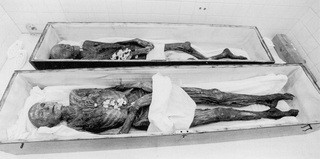 | Back to e-WV
| Back to e-WV
 The West Virginia Encyclopedia
The West Virginia Encyclopedia
 | Back to e-WV
| Back to e-WV
 The West Virginia Encyclopedia
The West Virginia Encyclopedia

Two mummies created in the late 19th century have become an unusual attraction at the Barbour County Historical Society Museum near the Philippi Covered Bridge. They are the work of Graham Hamrick, a Philippi store owner and part-time undertaker, who developed and patented a mummification process.
In 1888, after trials with vegetables and animals, Hamrick preserved two anonymous female corpses he had obtained from the West Virginia Hospital for the Insane in nearby Weston. Reportedly, Hamrick also mummified a hand, a human head, and a baby. The head and the baby have vanished; the hand was in the possession of a Charleston woman early in the 21st century. In 1892 Hamrick received patent no. 466,524 for an intricate preservation formula that included water, saltpeter, and sublimed sulfur set afire.
Sporadic viewings were reported through the years. Up until the mid-1960s, the mummies were a regular part of the Barbour County Fair where anyone older than 14 could pay to see them. West Virginia Hillbilly editor Jim Comstock visited Philippi in 1963 to write a story. He found the baby and two female mummies in a barn. Soon afterward, they again disappeared from public view. Frank Beyer purchased the mummies from a Hamrick family estate sale in 1970. Damaged in the flood of 1985, the mummies were treated by a local funeral home. They remain in the Beyer family’s possession and are on loan to the history museum.
Written by Jeanne Mozier
Lipton, Michael. Have You Saw the Mummies?. Charleston Gazette, 10/29/1989.
Smith, Barbara. 'Reserved until Judgment Day': The Philippi Mummies. Goldenseal, (Fall 2001).